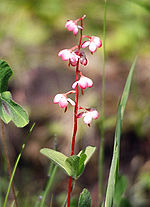
Pyrolaceae
Encyclopedia

Family (biology)
In biological classification, family is* a taxonomic rank. Other well-known ranks are life, domain, kingdom, phylum, class, order, genus, and species, with family fitting between order and genus. As for the other well-known ranks, there is the option of an immediately lower rank, indicated by the...
of flowering plant
Flowering plant
The flowering plants , also known as Angiospermae or Magnoliophyta, are the most diverse group of land plants. Angiosperms are seed-producing plants like the gymnosperms and can be distinguished from the gymnosperms by a series of synapomorphies...
s under the old Cronquist system
Cronquist system
The Cronquist system is a taxonomic classification system of flowering plants. It was developed by Arthur Cronquist in his texts An Integrated System of Classification of Flowering Plants and The Evolution and Classification of Flowering Plants .Cronquist's system places flowering plants into two...
of plant classification. It included the four genera
Genus
In biology, a genus is a low-level taxonomic rank used in the biological classification of living and fossil organisms, which is an example of definition by genus and differentia...
Chimaphila
Chimaphila
Chimaphila is a genus of five species of small, evergreen, flowering plants native to temperate regions of the Northern Hemisphere...
, Moneses, Orthilia
Orthilia
Orthilia secunda is a flowering plant of the genus Orthilia in the family Ericaceae. It is the only member of the genus. Its common name is sidebells wintergreen and it was previously part of genus Pyrola, the wintergreens....
, and Pyrola
Pyrola
Pyrola is a genus of evergreen herbaceous plants in the family Ericaceae. Under the old Cronquist system it was placed in its own family Pyrolaceae, but genetic research showed it belonged in the family Ericaceae. The species are commonly known as wintergreen, a name shared with several other...
, and sometimes also the eight genera formerly usually placed in the family Monotropaceae
Monotropaceae
Monotropaceae was a small family of flowering plants under the old Cronquist system of plant classification. It included 10 genera Allotropa, Cheilotheca, Hemitomes, Monotropa, Monotropastrum, Monotropsis, Pityopus, Pleuricospora, Pterospora, Sarcodes....
.
Recent genetic research by the Angiosperm Phylogeny Group
Angiosperm Phylogeny Group
The Angiosperm Phylogeny Group, or APG, refers to an informal international group of systematic botanists who came together to try to establish a consensus on the taxonomy of flowering plants that would reflect new knowledge about plant relationships discovered through phylogenetic studies., three...
has however demonstrated that these genera are all better placed in the family Ericaceae
Ericaceae
The Ericaceae, commonly known as the heath or heather family, is a group of mostly calcifuge flowering plants. The family is large, with roughly 4000 species spread across 126 genera, making it the 14th most speciose family of flowering plants...
.
The family was distinguished mainly by its herbaceous
Herbaceous
A herbaceous plant is a plant that has leaves and stems that die down at the end of the growing season to the soil level. They have no persistent woody stem above ground...
growth form, not being woody plant
Woody plant
A woody plant is a plant that uses wood as its structural tissue. These are typically perennial plants whose stems and larger roots are reinforced with wood produced adjacent to the vascular tissues. The main stem, larger branches, and roots of these plants are usually covered by a layer of...
s like the rest of the Ericaceae. The genera are native to cool temperate and arctic regions of the Northern Hemisphere
Northern Hemisphere
The Northern Hemisphere is the half of a planet that is north of its equator—the word hemisphere literally means “half sphere”. It is also that half of the celestial sphere north of the celestial equator...
. The common name wintergreen
Wintergreen
Wintergreen is a group of plants. Wintergreen once commonly referred to plants that continue photosynthesis throughout the winter...
(shared by several other plants) derives from their evergreen
Evergreen
In botany, an evergreen plant is a plant that has leaves in all seasons. This contrasts with deciduous plants, which completely lose their foliage during the winter or dry season.There are many different kinds of evergreen plants, both trees and shrubs...
leaves
Leaf
A leaf is an organ of a vascular plant, as defined in botanical terms, and in particular in plant morphology. Foliage is a mass noun that refers to leaves as a feature of plants....
.
The leaves are typically alternate or basal, and are always evergreen. The flowers are regular, most often with five sepals, five petals, and 10 anthers. The fruit are dry dehiscent capsules.

